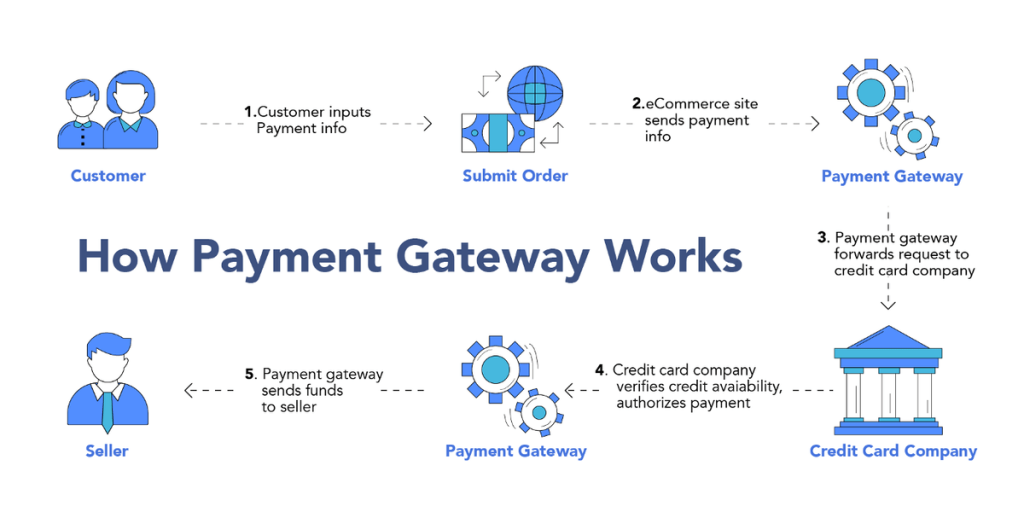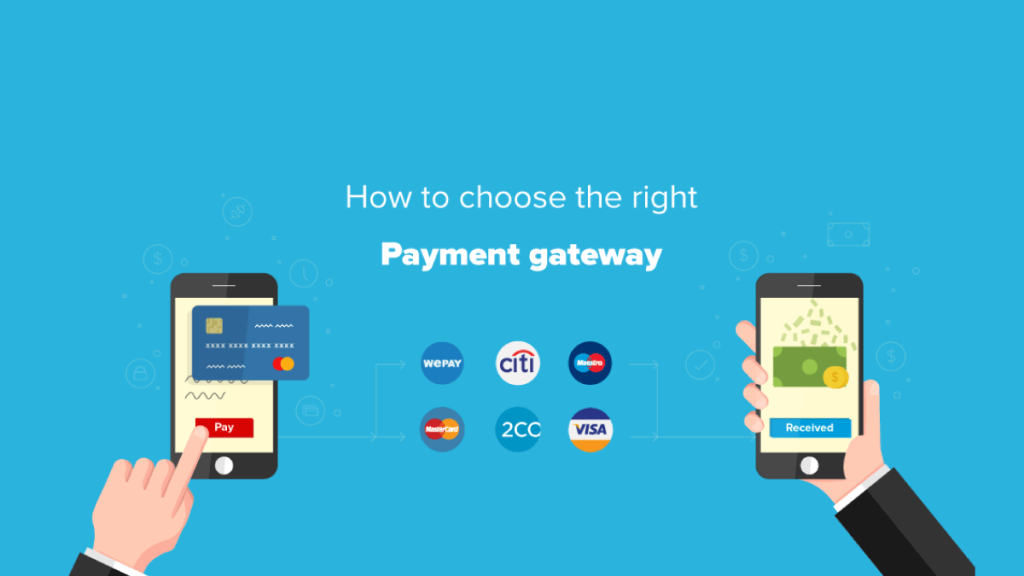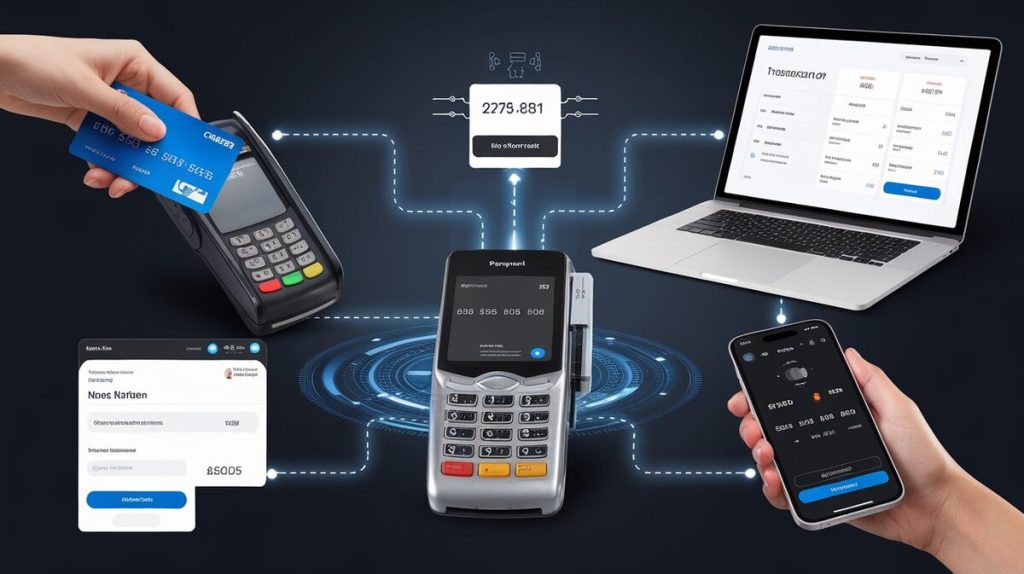Introduction
A payment gateway is a critical component in digital transactions, enabling merchants to accept payments securely and efficiently. In 2023, global e-commerce sales are projected to surpass $6 trillion, largely due to the widespread adoption of online payments. Payment gateways ensure businesses can handle these transactions smoothly, offering a reliable bridge between customers and financial institutions.
What is a Payment Gateway?
A payment gateway is a technology that connects a merchant’s online store or physical POS system with the financial institutions responsible for processing payments. It handles the transmission of payment details, ensuring transactions are secure and compliant with industry standards.
Key Functions of a Payment Gateway:
- Capturing Payment Details: The gateway collects payment information from customers, such as credit card details.
- Data Encryption: It encrypts sensitive data to prevent unauthorized access during transmission.
- Authorization: The gateway sends payment data to the acquiring bank for approval.
- Transaction Approval/Decline: The gateway relays the transaction status to both the merchant and the customer.
How Does a Payment Gateway Work?
The operation of a payment gateway involves several straightforward steps:
- Customer Initiates Payment: The process starts when a customer makes a purchase. The gateway captures the payment details, whether entered online or via a POS system.
- Encryption: The gateway encrypts the payment data to secure it during transmission.
- Authorization Request: The encrypted data is sent to the acquiring bank, which forwards it to the issuing bank (the customer’s bank).
- Transaction Approval/Decline: The issuing bank verifies the customer’s account and approves or declines the transaction, communicating back to the gateway through the acquiring bank.
- Completion: The gateway informs both the merchant and the customer of the transaction outcome. Approved transactions proceed to order fulfillment, followed by settlement where funds are transferred to the merchant’s account.
Example: Retailers using gateways like Stripe or Authorize.net process thousands of transactions daily, ensuring each is secure and efficient.

Key Features and Benefits
Payment gateways offer essential features that enhance transaction security, efficiency, and the overall user experience.
1. Security Features:
- Encryption and Tokenization: Gateways encrypt sensitive data and can tokenize card details, replacing them with a secure token.
- PCI DSS Compliance: Adherence to Payment Card Industry Data Security Standard (PCI DSS) ensures protection of card information during and after transactions.
- Fraud Detection: Advanced fraud detection tools, such as Address Verification Service (AVS) and Card Verification Value (CVV) checks, are standard features.
2. User Experience Enhancements:
- Multiple Payment Options: Gateways support various payment methods, including credit/debit cards, digital wallets, and cryptocurrencies.
- Faster Transactions: Streamlined authorization processes reduce transaction times, improving customer satisfaction and reducing cart abandonment rates.
3. Business Benefits:
- Global Reach: Gateways allow businesses to accept payments in multiple currencies, expanding their customer base internationally.
- Ease of Integration: Most gateways offer APIs or plugins for easy integration with e-commerce platforms like Shopify or WooCommerce.
Recommendation: For enhanced transaction security and chargeback reduction, consider integrating with Merchanto.org. As an official partner of VISA and MasterCard, Merchanto offers robust chargeback prevention solutions tailored to your business. Learn more at Merchanto.org.
Types of Payment Gateways
Payment gateways are designed to fit different business models and technical needs.
1. Hosted Payment Gateways:
- Description: Redirects customers to a third-party payment service provider (PSP) page to complete the payment. After payment, customers are redirected back to the merchant’s site.
- Example: PayPal and Stripe offer hosted gateway options.
- Pros: Simple to set up, secure, and requires minimal PCI compliance from the merchant.
- Cons: Limited control over the user experience, potentially leading to cart abandonment.
2. Self-hosted Payment Gateways:
- Description: The customer’s payment details are collected directly on the merchant’s website and then transmitted to the PSP for processing.
- Example: WooCommerce Payments and Magento’s built-in payment processing.
- Pros: Greater control over the checkout experience, seamless user experience.
- Cons: Requires PCI compliance and more technical expertise to implement.
3. API-hosted Payment Gateways:
- Description: Merchants customize every aspect of the payment process using APIs. The entire payment flow occurs on the merchant’s site.
- Example: Stripe API and Braintree.
- Pros: Maximum customization, ideal for businesses with complex payment needs.
- Cons: High implementation cost and requires significant technical expertise.
4. Local Bank Integration Gateways:
- Description: Routes transaction data to the most suitable local bank, which processes the payment.
- Example: Adyen offers local payment methods tailored to specific regions.
- Pros: Supports local payment preferences, improving conversion rates in specific markets.
- Cons: Complex integration, especially for businesses operating in multiple regions.
Table 1: Comparison of Payment Gateway Types
| Type | Pros | Cons | Examples |
|---|---|---|---|
| Hosted | Easy setup, secure, minimal PCI compliance | Limited control over UX | PayPal, Stripe |
| Self-hosted | Full control over checkout, seamless UX | Requires PCI compliance, technical expertise | WooCommerce Payments |
| API-hosted | Maximum customization, scalable | High cost, requires technical skills | Stripe API, Braintree |
| Local Bank Integration | Supports local preferences, boosts conversions | Complex integration, region-specific | Adyen |

Choosing the Right Payment Gateway
Selecting the appropriate payment gateway depends on your business model, target market, and security requirements.
Factors to Consider:
- Business Size: Larger businesses might need more robust solutions with higher customization capabilities.
- Transaction Volume: High transaction volumes benefit from gateways offering volume discounts or more efficient processing.
- Customer Base: Consider whether your customers prefer specific payment methods or require multi-currency support.
Common Payment Gateways:
- Stripe: Known for its developer-friendly API and support for a wide range of payment methods.
- PayPal: Popular among small to medium-sized businesses for its ease of use and consumer trust.
- Authorize.net: Offers a comprehensive solution for businesses of all sizes, including advanced fraud detection tools.
Table 2: Features of Popular Payment Gateways
| Gateway | Key Features | Ideal For | Fee Structure |
|---|---|---|---|
| Stripe | API customization, multi-currency support, scalability | Tech-savvy businesses, global reach | 2.9% + $0.30 per transaction |
| PayPal | Consumer trust, easy integration, multiple payment methods | SMEs, online retailers | 2.9% + $0.30 per transaction |
| Authorize.net | Fraud detection, recurring billing, omnichannel support | Enterprises, high-risk industries | $25 monthly fee + 2.9% + $0.30 per transaction |
Challenges and Limitations
While payment gateways offer significant advantages, there are challenges and limitations that businesses must consider.
1. Fees: Payment gateways often charge a combination of fixed and variable fees. For example, PayPal charges 2.9% + $0.30 per transaction, which can add up for businesses with high transaction volumes.
2. Limitations on Payment Methods: Not all gateways support every payment method. Some may not support specific credit cards or alternative payment options like cryptocurrencies.
3. Security Concerns: Despite advanced security measures, payment gateways are not immune to breaches. Ensuring PCI DSS compliance and implementing additional security layers, such as 3D Secure, can mitigate these risks.
4. Regional Restrictions: Certain gateways are optimized for specific regions, which can limit their effectiveness for businesses with a global customer base.
Table 3: Potential Challenges with Payment Gateways
| Challenge | Description | Mitigation Strategies |
|---|---|---|
| Fees | High transaction fees can erode profit margins | Negotiate fees, choose gateways with lower rates |
| Payment Method Limitations | Limited acceptance of certain payment types | Offer multiple gateways to cover gaps |
| Security Risks | Potential for data breaches or fraud | Implement multi-layer security, stay PCI compliant |
| Regional Optimization | Gateways optimized for specific regions may not perform well globally | Use local gateways for regional operations |
Conclusion
Payment gateways are essential for secure and efficient payment processing. Choosing the right gateway requires understanding your business needs, customer preferences, and technical capabilities. Gateways offer key benefits, from enhanced security features to global reach, making them vital for businesses aiming to thrive in today’s digital economy.



